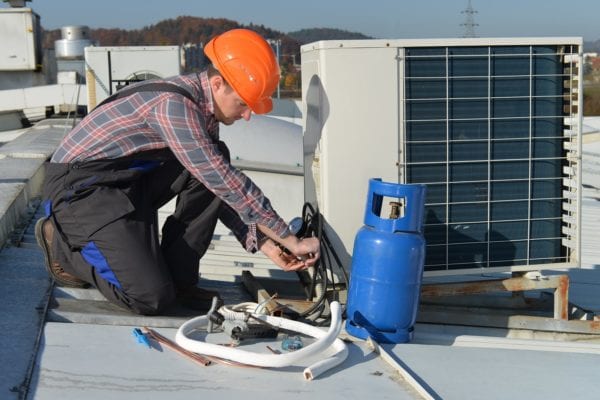At home or in the workplace, there will always be unexpected repairs—like when a falling tree branch breaks a window. You have to install a new window, which is corrective maintenance. Other major repairs may be avoided if the correct preventive maintenance is performed ahead of failure.
For example, you might decide to trim off a dead or overhanging branch before it falls during the next storm and breaks the window, which would be preventive maintenance. Due to budget constraints, miscommunication from management, or limited resources, in some production environments, it may not always be obvious when to use corrective vs. preventive maintenance. We’ll help you make informed decisions by discussing and comparing them both in detail.
About Corrective Maintenance

Corrective maintenance (CM) is maintenance performed to restore a non- or under-performing asset to an optimum or operational condition. Examples of corrective maintenance include:
- Pulling weeds as part of facilities maintenance
- Replacing the alternator in a fleet vehicle after it refused to start
- Replacing an entire machine in a production line post-failure
- Changing a belt on a machine that malfunctioned
Corrective maintenance can fall into two categories: scheduled and unscheduled. Scheduled corrective maintenance is a repair that needs to be made, but doesn’t have to be performed immediately. Unscheduled corrective maintenance occurs when a repair is required immediately due to the failure of an asset critical to production. As you may have guessed, unscheduled corrective maintenance usually takes priority over scheduled corrective maintenance.
While corrective maintenance can get a bad rap, it is a valid maintenance strategy and in some cases, the best type of maintenance to perform. It has advantages such as less planning required, a simplified need-based process, and saving money when maintenance involves a simple process (minimal labor) replacing inexpensive parts.
Read Blog Post: What is Corrective Maintenance?
About Preventive Maintenance

Preventive maintenance (PM) is maintenance that is proactively performed on an asset with the goal of lessening the likelihood of failure, reducing unexpected downtime, and prolonging its useful life. Examples of preventive maintenance include:
- Changing the oil on a riding lawn mower
- Cleaning an air duct
- Replacing rusted bolts on a machine
- Inspecting a production line asset
Just like with corrective maintenance, there are two types of preventive maintenance: calendar-based and runtime-based. Calendar-based PM is done on a planned, periodic basis, anywhere from once per week to once per year. Runtime-based PM is done based on how long a machine has been operating since the last preventive maintenance task was performed on the asset. For example, you might schedule lubrication of a machine after every 3000 hours of runtime.
Preventive maintenance has a number of advantages, including improved scheduling, lower, more controlled maintenance costs, and less stressful preparation since parts, supplies, and labor are scheduled to be available ahead of time.
Read Blog Post: What is Preventive Maintenance?
Difference Between Corrective and Preventive Maintenance
If you’ve been getting by without a preventive maintenance plan in place, is shifting the focus to preventing machine failure really worth the effort? See the chart below for a comparison of corrective and preventive maintenance.
| Corrective Maintenance | Preventive Maintenance | |
| When Task is Assigned | At time of asset failure | Scheduled prior to asset failure |
| Cost | Medium to High | Low |
| Savings | None, often adds to expenses | 20% or more per year |
| Resource Deployment | At time of asset failure |
|
| Pros |
|
|
| Cons |
|
|
| Example | Repairing a large-scale printer after the motor burns out | Cleaning ink off the parts and lubricating the printer motor before failure |
The recommended balance for maintenance is 80% preventive to 20% corrective. While you want to lean toward preventive maintenance whenever possible, corrective maintenance is still important and will never be eliminated completely. A cost-benefits analysis on all of your assets may help to support the case for scheduled corrective maintenance.
As we mentioned earlier, some corrective maintenance is unexpected and unavoidable, but you should still approach these sudden repair jobs in an organized, systematic way. Ideally, you want to use PM to extend the lifespan of all your assets, but you need to prioritize when you’re just starting out. Begin with the assets that are essential to production.
Ultimately, making decisions about when to use preventive or corrective maintenance depends on your industry, organizational goals, and types of equipment you maintain. However, a CMMS can help to make those decisions easier.
FTMaintenance Helps with Corrective and Preventive Maintenance
FTMaintenance is a CMMS with features such as preventive maintenance task lists, automated work order notifications, and auto-distribution. This powerful software helps organizations take control of their maintenance operations, fostering a shift from an emphasis on reactionary corrective maintenance to more planned preventive maintenance. As a result, more breakdowns are prevented, major repairs and unplanned shutdowns are reduced, and asset life expectancy is increased. Take a tour to learn more about FTMaintenance.